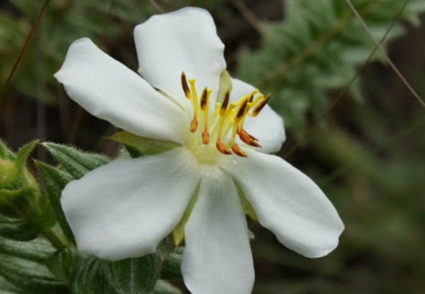Abstract
Microlicia indurata is described as a new species from cerrado rupestre in the Serra dos Pireneus of Goiás, Brazil. Illustrations, photos taken in the field, a distribution map, a recommended conservation assessment, and a discussion of putative related species based on morphological similarities are provided. Microlicia indurata is readily recognized by its openly branched shrubby habit, sessile elliptic-lanceolate to elliptic-ovate 5–7-nerved leaf blades that are moderately to copiously covered with short (mostly 0.5–0.7 mm) gland-tipped trichomes on both surfaces, 6-merous, solitary, sessile flowers, caducous calyx lobes that greatly exceed the hypanthia at anthesis, white petals, red antesepalous (large) anthers, 6-locular ovaries that are ca. ⅓ inferior, and mature capsules that are hard and woody with a somewhat protruding tapered acute apex. It is compared with M. pohliana, its presumed closest relative, and the superficially similar M. mucorifera and M. nervulosa.
References
- Bachman, S., Moat, J., Hill, A.W., de la Torre, J. & Scott, B. (2011) Supporting red list threat assessments with GeoCAT: Geospatial conservation assessment tool. ZooKeys 150: 117–126. https://doi.org/10.3897/zookeys.150.2109
- Beentje, H. (2016) The Kew Plant Glossary: an illustrated dictionary of plant terms. 2nd ed. Kew Publishing, Royal Botanic Gardens, Kew, 184 pp.
- Candolle, A.L.P.P. de (1828) Melastomataceae. In: Candolle, A.L.L.P. de (ed.) Prodromus systematis naturalis regni vegetabilis 3. Paris, Treuttel et Würtz, pp. 99–202.
- Castro, J.D.A.B., Barros, J.F.S., Silva, M.R. & Santos, M.G. (2019) Conservation units, ecological attributes and their implications: The case of the Park and EPA of the Pireneus/GO. Sustainability in Debate—Brasilia 10: 48–62. https://doi.org/10.18472/SustDeb.v10n3.2019.24330
- Cogniaux, A. (1906) Notice biographique sur Auguste Glaziou. Bulletin de la Société Royale de Botanique de Belgique 43: 365–369.
- Don, D. (1823) [“1822”] An illustration of the natural family of plants called Melastomaceae. Memoirs of the Wernerian Natural History Society 4: 276–329.
- Glaziou, A.F.M. (1908) [“1905”] Plantae brasiliae centralis a Glaziou lectae. Bulletin de la Societé Botanique de France. Mémoires 1 (3): 201–296. https://doi.org/10.5962/bhl.title.4336
- Goldenberg, R., Baumgratz, J.F.A., Michelangeli, F.A., Guimarães, P.J.F., Romero, R., Versiane, A.F.A., Fidanza, K., Völtz, R.R., Silva, D.N., Lima, L.F.G., Silva-Gonçalves, K.C., Bacci, L.F., Fontelas, J.C., Pacifico, R., Brito, E.S., Rocha, M.J.R., Caddah, M.K., Meirelles, J., Rosa, P., Ferreira-Alves, R., Santos, A.K.A., Moreira, K.V.C., Reginato, M., Oliveira, L.F.A., Freire-Fierro, A., Amorim, A.M.A., Martins, A.B., Koschnitzke, C., Almeda, F., Jesus, J.C., Hinoshita, L.K.R. & Kriebel, R. (2020) Melastomataceae in Flora do Brasil 2020. Published by the Jardim Botânico do Rio de Janeiro. Available from: http://floradobrasil.jbrj.gov.br/reflora/floradobrasil/FB161 (accessed 15 July 2023).
- Harris, J.G. & Harris, M.W. (2001) Plant identification terminology: an illustrated Glossary. 2nd ed. Spring Lake Publishing, Spring Lake, Utah, 206 pp.
- IUCN (2012) IUCN Red List categories and criteria. Version 3.1. Second edition. Gland and Cambridge, IUCN Press. Available from: https://www.iucnredlist.org/resources/categories-and-criteria (accessed 15 July 2023).
- IUCN Standards and Petitions Subcommittee (2022) Guidelines for Using the IUCN Red list Categories and Criteria. Version 15. Prepared by the Standards and Petitions Subcommittee. Available from: http://www.iucnredlist.org/documents/RedListGuidelines.pdf (accessed 15 July 2023).
- Mansano, V.F. & Pederneiras, L.C. (2016) Proposal to add Glaziou’s “Plantae Brasiliae centralis a Glaziou lectae” to the list of suppressed works in Appendix VI. Taxon 65 (5): 1181–1182. https://doi.org/10.12705/655.28
- Martins, A.B. & Almeda, F. (2017) A monograph of the Brazilian endemic genus Lavoisiera (Melastomataceae: Microlicieae). Phytotaxa 315: 1–194. https://doi.org/10.11646/phytotaxa.315.1.1
- Medeiros, J.D. (2011) Guia de campo: vegetaçao do Cerrado 500 species (Série Biodiversidade 43). Ministerio do Meio Ambiente/Secretaria de Biodiversidade e Floresta, Brasília, 532 pp.
- Munhoz, C. & Proença, C. (2000) Validating an endemic Melastomataceae from Goiás, Central Brazil: Lavoisiera fragilis Cogn. ex Munhoz & Proença. Novon 10: 60–63. https://doi.org/10.2307/3393186
- Naudin, C.V. (1844) Additions à la flore du Brésil méridional. Description de genres nouveaux, et rectification de quelques anciens genres appartenant à la famille des Mélastomacées. Annales des Sciences Naturelles: Botanique sér. 3, 2: 140–156.
- Pacifico, R. & Almeda, F. (2022) Lavoisiereae: A Neotropical tribe with remarkable endemism on eastern Brazilian mountaintops. In: Goldenberg, R., Michelangeli, F.A. & Almeda, F. (eds.) Systematics, Evolution, and Ecology of Melastomataceae. Springer, Cham, Switzerland, pp. 385–408. https://doi.org/10.1007/978-3-030-99742-7_19
- Proença, C, Oliveira, R.S. & Silva, A.P. (2000) Flores e frutos do Cerrado. Editora Universidade de Brasília, 225 pp.
- QGIS Development Team (2023) QGIS Geographic Information System. Open Source Geospatial Foundation Project. Available from: http://qgis.org (accessed July 2023)
- Santos, K. (2016) Brazilian plant specimens at the Regnellian herbarium: history and repatriation. Rodriguésia 67: 879–892. https://doi.org/10.1590/2175-7860201667403
- Sax, S. (2023) An ancient South American landscape in peril. Audubon 125 (2): 40–45, 63.
- Thiers, B. (2023) [continuously updated] Index Herbariorum: A global directory of public herbaria and associated staff. New York Botanical Garden’s Virtual Herbarium. Available from: http://sweetgum.nybg.org/science/ih/ (accessed 30 June 2023)
- Triana, J.J. (1872) [“1871”] Les Mélastomacées. Transactions of the Linnean Society of London 28 (1): 1–188. https://doi.org/10.1111/j.1096-3642.1871.tb00222.x
- Turland, N.J., Wiersema, J.H., Barrie, F.R., Greuter, W., Hawksworth, D.L., Herendeen, P.S., Knapp, S., Kusber, W.-H., Li, D.-Z., Marhold, K., May, T.W., McNeill, J., Monro, A.M., Prado, J., Price, M.J. & Smith, G.F. (eds.) (2018) International Code of Nomenclature for algae, fungi, and plants (Shenzhen Code) adopted by the Nineteenth International Botanical Congress, Shenzhen, China, July 2017. Regnum Vegetabile 159. Glashütten: Koeltz Botanical Books. https://doi.org/10.12705/Code.2018
- Versiane, A.F.A., Santos, M.L. & Romero, R. (2016) Melastomataceae na Serra dos Pireneus, Goiás, Brasil. Rodriguésia 67: 721–759. https://doi.org/10.1590/2175-7860201667314
- Versiane, A.F.A., Romero, R., Reginato, M., Welker, C.A.D., Michelangeli, F.A. & Goldenberg, R. (2021) Phylogenetic analysis of Microlicieae (Melastomataceae), with emphasis on the re-circumscription of the large genus Microlicia. Botanical Journal of the Linnean Society 197: 35–60. https://doi.org/10.1093/botlinnean/boab011


